Why is bone broth so healthy?? Answer:
1. Heal and seal your gut. The gelatin in bone broth protects the gut by supporting mucosal lining, and by providing proteins that support the immune system.
2. Protect your joints. Taking glucosamine supplements to help with joint pain has been common knowledge for years, but it turns out that bone broth has glucosamine too. But unlike pills, the broth also includes a host of other goodies that help keep your joints happy, healthy, and pain-free. The chondroitin sulfate in bone broth has been shown to help prevent osteoarthritis.
3. Look younger. Bone broth is a rich source of collagen. You can find collagen in all kinds of “plumping” products these days, but why stick it on the outside when you can drink it? Not only is drinking it cheaper, but it can make your skin, hair, and nails look just as radiant.
4. Sleep better, and feel better. The glycine in bone broth has been shown in several studies to help people sleep better and improve memory by supporting neurotransmitter formation.
5. Immune support. Mark Sisson, author of The Primal Blueprint, actually calls bone broth a “superfood” thanks to the high concentration of minerals. He says that the bone marrow can help strengthen your immune system. (Something that won’t surprise your grandma who always made you her famous chicken soup when you got sick!) A Harvard study even showed that some people with auto-immune disorders experienced a relief of symptoms when drinking bone broth, with some achieving a complete remission.
6. Stronger bones. The phosphorus, magnesium, and calcium in the bones seeps out into the broth leaving you with the essential building blocks for healthy bones.
7. It’s very economical! What else were you going to do with those chicken carcasses, soup bones, and veggies going bad in your fridge?
Bone Broth
- 4 lb Bones free range chicken bones, beef marrow/ any organic bones labelled 'soup'- may even use fish heads
- 1/2 cup apple cider vinegar
- 4 quarts water
- 3 stalks celery
- 3 medium carrots halved
- 3 medium onions quartered
- 1 bunch parsley
- 1 tbsp sea salt
1. Place bones, vinegar, and water in large stew pot. Let sit for one hour. Add more water if needed to cover bones.
2. Transfer pot to stove top. On medium heat, add celery, carrots, and onions. Bring to boil, and skim any film from top; discard.
3. Reduce to simmer. Cover and cook for 24-72 hours (can turn off burner overnight, put pot in fridge, and restart in morning if you prefer)
4. For the last 10 minutes, add the parsley.
5. Cool broth in refrigerator for 30 minutes to 1 hour. Strain broth and discard bones and vegetable remnants.
6. May store in fridge for up to 7 days. May freeze broth in ice cube trays, or freezer safe containers for up to 6 months.
Use in soups, stews, smoothies, or drink on it's own.






